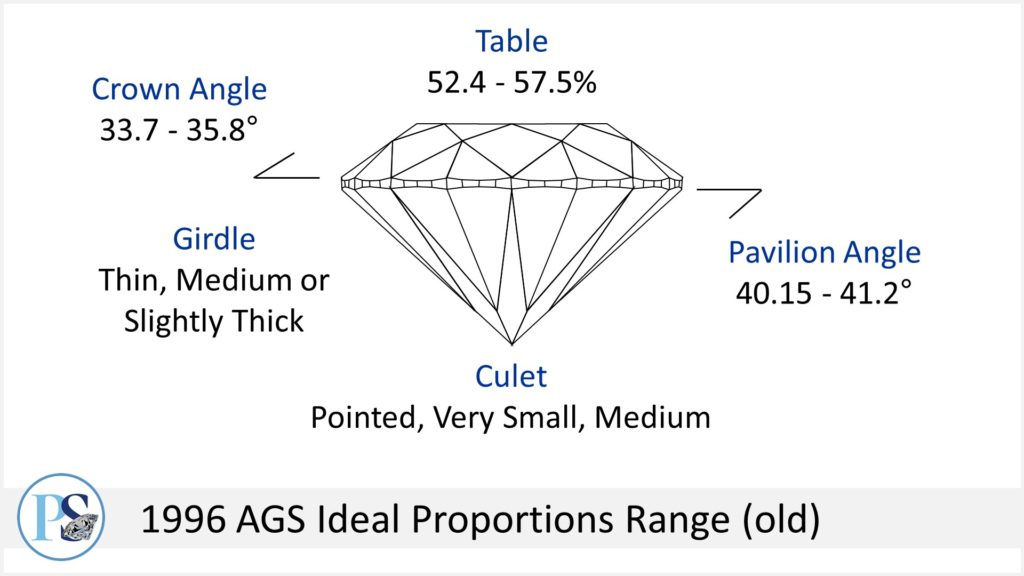How Are Diamonds Made? Natural vs Lab-Created Explained
Two Paths, One Diamond Not all diamonds come from the same place — but they all start the same way. Pure carbon, crystalized under immense pressure and heat. Whether it…
Ideal Cut Diamond – Basics
Ideal is probably the most abused buzzword in the diamond business. Before buying an “ideal cut diamond” be sure the word ideal actually appears on the diamond’s grading report.
PriceScope Pointer: GIA does not use the word ideal and does not issue a cut grade for fancy shapes.
Before going on: Check out the PriceScope Diamond Buying Guide
For more than 50 years “diamond cut” only described a diamond’s shape: round, oval, pear, etc. Even GIA, the world’s most dominant laboratory, made no judgment about a diamond’s all-important visual properties. This only changed after the internet was opened to the public in 1991 and diamonds started being traded online.
1996 AGS Ideal Diamond Proportions
Responding to increasing demand for diamond cut grading, the American Gem Society (AGS) laboratories opened in 1996, offering traditional assessment of carat, color, and clarity and full cut assessment for round brilliants. This was the first strict, meaningful use of the term ideal cut diamond. To qualify as ideal, a diamond was required to be produced within a range of “ideal cut proportions;” using combinations of cutting angles proven to successfully reflect light entering the diamond back to the viewer’s eyes.

The AGS ideal cut diamond, and ideal diamond proportions, earned a positive reputation among jewelers seeking beautiful diamonds. For internet sellers an AGS ideal cut could be touted as having superior optical qualities to diamonds without that designation. For online shoppers an ideal cut diamond, independently confirmed for superior beauty by the AGS, represented a safe choice.
2005 AGS Ideal Light Performance Assessment
In 2005 AGS updated their grading system, moving from 2D assessment of averaged proportions to 3D assessment of light behavior within each specific diamond, using a process called ray tracing. This is done by importing a 3D scan of the diamond into ray tracing software and tracking 40,000 rays of light over a range of tilt to calculate values for brightness, contrast, and leakage.

The 2005 AGS system is the world’s only diamond-specific cut grade to date. In other words, only AGS calculates repeatable scientific light behavior values for each diamond using a scan of its total sculpture. All other laboratories cross-reference a diamond’s average measurements with charts to determine the correlating cut grade.
Fancy Shapes
The 2005 AGS metric can also be used to assess fancy shapes, as well as round diamonds. Light performance reports from AGS are available for princess, oval, emerald and cushion-shaped diamonds.

When interpreting diamond cut there is a difference between “AGS Ideal” and other ideal labels. An ideal cut diamond will have the word “ideal” printed on its laboratory grading report. The strictest iteration is the AGS Platinum Report, which uses the scientific Light Performance metric.
“GIA Ideal” Doesn’t Exist
The GIA does not use the term ideal. They introduced a cut grade for round diamonds in 2006 with a top grade of Excellent, which is nowhere near as strict as AGS Ideal. Nevertheless, many sellers of GIA graded diamonds label them ideal cut diamonds because it sounds nice: despite most GIA Excellent diamonds being unable to quality for that designation from AGS.
PriceScope Pointer: Over 60% of round diamonds passing through GIA receive their top cut grade of Excellent, despite being produced for weight over beauty.
Ideal Fancy Shapes
The GIA does not grade cut for shapes other than round. Nevertheless, many sellers advertise “ideal cut” GIA graded princess, cushions, ovals, pears, and other shapes. Be advised that when “ideal cut” is used for these fancy shapes it’s usually a seller-applied label. GIA does not use the term ideal, nor does GIA evaluate fancy shape cut quality.
The only laboratories issuing a cut grade for shapes other than round are the AGS and GCAL.
AGS Ideal fancy shapes: Our vetted vendors Whiteflash and James Allen offer Princess Cuts and other fancy shapes graded using the AGS Platinum Report.
The word ideal , applied to cut quality, is probably the most abused word in the diamond trade. AGS established the term in 1996 with a strict set of standards, elevating the word to elite status. The term was not trademarked, however, which permits any seller to use it in promotions for any diamond.
Today there are sellers using the terms ideal or ideal cut to promote diamonds which would never pass AGS ideal standards: they are taking a term with perceived meaning and applying it meaninglessly.
Before their closure, the European Gemological Laboratories (EGL) added to this abuse by printing grading reports for their own EGL “ideal cut diamond,” using a scandalously wide range of proportions which did not come close to the strictness of AGS’ requirements. This permitted unscrupulous sellers to show buyers ideal cut diamond reports for stones of very average cut quality. The Rapaport Group and PriceScope ultimately banned EGL diamonds from being listed on our platforms.
So many sellers and wholesalers have jumped on the ideal cut diamond abuse bandwagon over time that the term ideal cut diamond has become diluted. Today it’s essentially meaningless without more information.
Cut unarguably has the most influence on a diamond’s beauty. When shopping on the internet, it’s especially important to research this topic. If you have not read our main page on cut you can find it here, Diamond Cut: Everything You Need To Know.
Get fast answers to any question: Ask our community of unbiased independent helpers.
Ready to find your diamond?